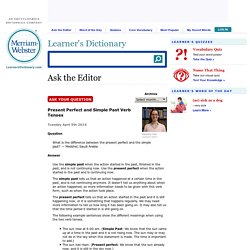

Past & Present Perfect site:thegrammarexchange.infopop.cc. Tense. It's interesting that Richard and Jerry have presented different versions of what is correct here.

I think they are both right! Kis is also correct in noticing that people who speak British English use the present perfect in some cases where people who speak American English use the simple past, even with "just. " Swan* states: Present perfect - simple past. The present perfect has more than one use.

The verb can be in the present perfect when the action may be performed more times, or the action is still to be performed. For a completed action, the past may be used. For example: A: Where did you have lunch today? B: At the new restaurant across the street.A: How was it? "simple past tense" vs "present perfect" I know we cannot use "present perfect tense" to talk about a finished action that have mentioned time frame.

But my question is different. Suppose, something happened yesterday but I do not want to mention the time rather I want to describe what happened. BBC Learning English - Course: The Grammar Gameshow / Unit 1 / Session 30 / Activity 1. Advanced Level: Present Perfect Tense. Form The Present Perfect is made with – has/have + past participle I have read that book. Have you read that book? I have not read that book. Present Perfect and Past Simple. Present perfect and past simple. Lesson B present perfect or past simple (2) Lesson B present perfect or past simple (1) Exercise 1 - Past simple and present perfect contrast. Present perfect. Level: beginner The present perfect is formed from the present tense of the verb have and the past participle of a verb.

We use the present perfect: for something that started in the past and continues in the present: BBC Learning English - Course: lower intermediate / Unit 26 / Grammar Reference. BBC Learning English - Course: lower intermediate / Unit 26 / Session 2 / Activity 3. BBC Learning English - Course: lower intermediate / Unit 26 / Session 2 / Activity 3. Lesson B present perfect or past simple (1) What is the difference between the present perfect and the simple past? What is the difference between the present perfect and the simple past?

— Medshel, Saudi Arabia Use the simple past when the action started in the past, finished in the past, and is not continuing now. Use the present perfect when the action started in the past and is continuing now. The simple past tells us that an action happened at a certain time in the past, and is not continuing anymore. What is the difference between the present perfect and the simple past? Present Perfect and Simple Past 1. In each sentence, choose the correct form of the verb.

Click on the button beside the correct answer. I ________ to work every day for the last six weeks! Walked have walkedChika ________ from university last July. graduated has graduatedJoji ________ in Tokyo for five years, but he left in 1993. lived have livedI ________ the movie Titanic three times. Present perfect simple ( I have worked ) We use the present perfect simple to refer to events in the past but which connect to the present.

We use the present perfect simple to talk about our experiences up to now. The time of the experiences is not important: Past simple or present perfect? Past simple = I worked Present perfect = I have worked We use the past simple to refer to definite time in the past (when we specify the time or how long) and usually with past time expressions such as yesterday, two weeks ago, last year, in 1995: We met in January 1975.

Present Perfect: Present Perfect or Simple Past? Each of these sentences should be either simple past or present perfect.

The simple past is usually used with definite times (such as "at six o'clock"), while the present perfect is usually used if an action started in the past and is still going on now. Choose the best tense for each sentence. Click on the button beside the correct answer. I ________ these boots to go hiking yesterday. wore have wornThis wine ________ in the cellar for 15 years. How to Teach the Present Perfect for ESL Students. The present perfect is one of the most difficult tenses to learn for students.

Teaching the present perfect effectively involves making sure students understand that the present perfect in English is always connected in some way to the present moment in time. Many languages including French, German, Spanish and Italian use the present perfect for past events. The present perfect in English covers what happens from a past moment to the present moment in time. Establishing this connection in students' minds early will help students avoid mistakes. English Grammar Explanations - Present Perfect. The present perfect tense is most often used for the following: - For past events with a connection to the present - With words of unfinished time How to form the present perfect | Present perfect continuous For past events with a connection to the present The present perfect tense is quite complicated to explain.
Simple Past and Present Perfect. In this week’s episode of Everyday Grammar we’re going to help you understand the difference between the simple past and the present perfect. English learners often confuse these two verb tenses. Let’s start with an example. Can you tell the difference between these two sentences? Sentence one: I saw the movie. Past Simple or Present Perfect - English Quiz. Past perfect and future perfect. How to Teach the Present Perfect for ESL Students.